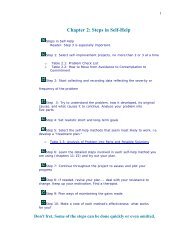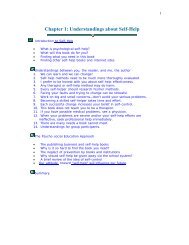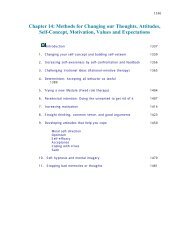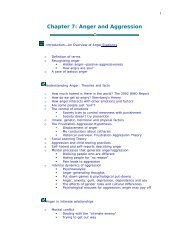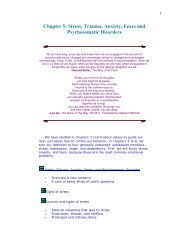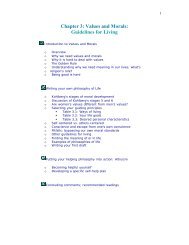Methods for Changing Behaviors - Psychological Self-Help
Methods for Changing Behaviors - Psychological Self-Help
Methods for Changing Behaviors - Psychological Self-Help
Create successful ePaper yourself
Turn your PDF publications into a flip-book with our unique Google optimized e-Paper software.
If you are a compulsive house cleaner, being asked (by a<br />
therapist) to spend twice as much time cleaning can be taxing. If you<br />
do it, however, and the therapist then seriously suggests that you dust<br />
everything, wash all the dishes (clean ones too), and wax the floors<br />
twice a day, it becomes ridiculous--hopefully, you can even see how<br />
funny your cleaning needs are becoming. The procedure of asking the<br />
person, or yourself, to do the unwanted and already-too-frequent<br />
behavior even more often is called "paradoxical intention." This<br />
method is discussed in detail in chapter 14, method #6.<br />
Many unwanted habits become unpleasant when they are<br />
continued <strong>for</strong> a long time, i.e. satiated. Example: if one smokes too<br />
much it may become nauseating, even to the addicted smoker<br />
(especially in a very small room). Being required to bite your nails or<br />
to worry continuously <strong>for</strong> 5 minutes every hour may become<br />
unpleasant (see "aversive conditioning"--method #18). Thus, these<br />
behaviors should occur less frequently.<br />
In some instances, paradoxical behaviors result in the person<br />
saying "enough is enough" and learning a new behavior. In other<br />
instances, the continuation of the unwanted behavior becomes<br />
punishing and so we drop it. In other situations, an unwanted behavior<br />
that seems determined to occur in spite of your opposition will go<br />
away as soon as you start demanding paradoxically that the behavior<br />
occur more frequently (like a crying child, who hopes he/she is<br />
bothering you, stops when asked to cry harder and longer). In the<br />
opposite direction, Wegner (1989) contends that obsessions develop<br />
because we try to suppress them, which causes the thought to come<br />
on even stronger. There<strong>for</strong>e, the solution is to "stop the stopping" and,<br />
instead, just let the thought occur or perhaps encourage it.<br />
Purpose<br />
Steps<br />
· To reduce compulsive, repetitive behaviors (or thoughts).<br />
STEP ONE: Determine how often the unwanted behavior is<br />
occurring.<br />
See method #8<br />
STEP TWO: Set a goal of drastically increasing the frequency of<br />
the unwanted behavior.<br />
In many applications, the increased frequency eventually makes<br />
the situation unpleasant. For this to happen in some cases, the<br />
behavior has to be done in special circumstances--like smoking with<br />
your head in a box. In other cases, the habit just naturally produces<br />
discom<strong>for</strong>t if overdone.<br />
1111



